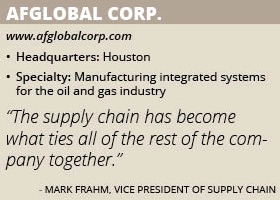AFGlobal Corp.
By building a strong supply chain, AFGlobal Corp. enhanced its business and strengthened its culture.
By Staci Davidson, Senior Editor at Knighthouse Publishing
Serving complex industries needs a well-organized operation to maintain a high level of service. Working with the global oil and gas, power generation, industrial and aerospace markets, AFGlobal Corp. understands this well. Five years ago, AFGlobal realized it wouldn’t be able to achieve sustainable growth without a strong supply chain, so it set out to establish one.
The company’s first step was to hire Vice President of Supply Chain Mark Frahm, who has more than 20 years of experience in supply chain management and sourcing. Frahm started by hiring Director of Supply Chain Bryan Minch because the two of them had worked together before and Frahm “needed a strategic initiatives guy,” he says. From there, they built the company’s supply chain as it exists today. 
“They had some overarching corporate functions but there wasn’t anything that really pulled things together what happened outside of the four walls of the plant,” Frahm explains. “The company needed strong sourcing, purchasing, logistics management and global materials management, and at that time, all of that was loosely run with some oversight. But when they started growing, they found not having a supply chain was detrimental to the company’s overall functions.”
AFGlobal is an oil and gas OEM that specializes in technology, products and services with fully integrated manufacturing capabilities. Based in Houston, the company has more than 20 facilities worldwide, and its capabilities also involve highly engineered and general forged products, as well as aftermarket services. Frahm and Minch came on board and helped the company manage its freight and logistics globally, manage global inventory, provide forecasting and help the facilities with their demand planning. Frahm notes this required a lot of culture change and environment management, but ongoing communication helped ensure the changes were visible and everyone was on the same page.
“First, you have to assess what you have internally,” Frahm explains. “What elements do we have that makes up the supply chain that currently exists? Next, we had to understand all the verticals in the business, how each element is organized and who is responsible for what. We needed to know where were their pain points and get their perspectives on how materials flow and the business operates. Then, I had to see if there was a structure in place to support that.”
Ongoing Growth
Frahm needed a larger team to build the supply chain AFGlobal required, so he hired some people from outside the organization and brought over a few of AFGlobal’s existing employees. To ensure a successful culture change, he notes, it’s important to not bring too many people from outside the organization. The team started by going after the “low-hanging fruit,” also known as the easy-to-address issues. That allowed AFGlobal to consolidate its buy and rationalize its supply base. But in 2015, the company hit the downturn in the oil and gas market, and the supply chain had a new set of challenges.
“Now things are going well – revenue is up, spend is up and we are back on plan,” Frahm says. “There is a business flow that allows us to implement these activities, and a new CFO brought in new financial people to add more rigor. That’s allowed us to do more from a supply chain perspective, and we’ve done 12 procedures for compliance. This has helped us with things like inventory management, cycle counting, how we manage the ERP system, S&OP and forecasting.”
Now Frahm is focused on training to change the company’s way of thinking. “We are training the spectrum from tactical to operational to strategic,” he says. “Tactical is the physical way of doing things, operational is adding more insight and awareness to what happens around you, and strategic is thinking longer term. For example, looking for suppliers that will grow with you and designing components with the suppliers and engineering department.
“We added people to ramp up, but now we have to make sure they are trained,” he adds. “We went from a vertically integrated structure where everyone was doing their own thing and there was no cross pollination. But the supply chain has become what ties the rest of the company together, and the business is growing quickly.”